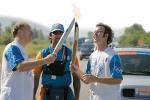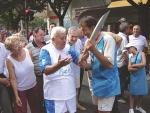How we kept the flame alive
Adelaide has made its mark on Olympic history - again. The team responsible for developing the all-important Olympic flame for Sydney in 2000 has done it again for Athens, and gone one better. After the success of the Games in Athens, the team - headed by Adelaide company FCT-Combustion, and involving staff, students and graduates of the University of Adelaide - has spoken to the Adelaidean about their involvement in the flames for the 2004 Olympics. The Adelaide team designed and manufactured the burner systems and controls that produced all of the flames for Athens 2004, including: - the flame for the torch relay;
- the flame for the main stadium cauldron ("the giant torch");
- and the rings of fire for the opening ceremony.
The Olympic flame is one of the most highly visible representations of the Games, with the torch relay spanning five continents, including 26 countries and 34 cities, before arriving in Greece, the original home of both the ancient and modern Olympic Games. The opening ceremony is one of the most watched events worldwide, with hundreds of millions of people believed to have seen the ceremony on television. "FCT was honoured and proud to have won the contracts for the engineering design and supply of all associated equipment that produced the flames for the Athens Olympics, against stiff opposition," said Mr Steven Hill, Senior Combustion Engineer with FCT-Combustion. "The performance of the FCT/University of Adelaide team providing similar systems and equipment for the Sydney Olympics was compelling evidence of the Adelaide team's capability. Having won the contracts, FCT had no hesitation in involving our long-term technical collaborators from the University of Adelaide to provide much-valued expertise during the course of executing these projects. "The results of the group's hard work were again clear for the world to see, adding significantly to the fantastic spectacle of the opening ceremony," Mr Hill said. More than a dozen staff and students from the university's School of Mechanical Engineering and FCT-Combustion were involved in producing the flames for Athens. Together, the university engineers and FCT have a long and successful history of collaboration, with years of expertise in turbulence, energy and combustion. Testing of the various flame systems and fire effects was primarily conducted at Adelaide University Research Park - Thebarton Campus, which is also the base of FCT-Combustion. Regular trips to Athens were also required to consult with Olympic organisers. "As with the Sydney Games, the team was able to provide flames that were environmentally friendly, highly stable during windy conditions, and extremely visible to the public," said aerodynamics expert Dr Richard Kelso (School of Mechanical Engineering). The rings of fire were something additional for these Games and they posed a unique challenge, as they required setting fire to several rings - in sequence - on water. "The whole team enjoyed rising to that challenge, and the final result made a lasting impression on almost everyone who saw it," Mr Hill said. Dr Kelso and FCT-Combustion staff member Dr Jordan Parham were among the team members who travelled across the world, providing assistance and technical advice during the torch relay as it made its way across the globe and onto Greece. Dr Parham, a PhD graduate of the University of Adelaide and now Combustion Engineer with FCT, was one of the students who worked on the fuel and combustion system for the Sydney 2000 Olympic torch. "These projects have become an important part of our students' learning over the years, and Jordan is one of those who has now worked on the Olympic flame both as a student and as a project leader," Dr Kelso said. Story by David Ellis
|





